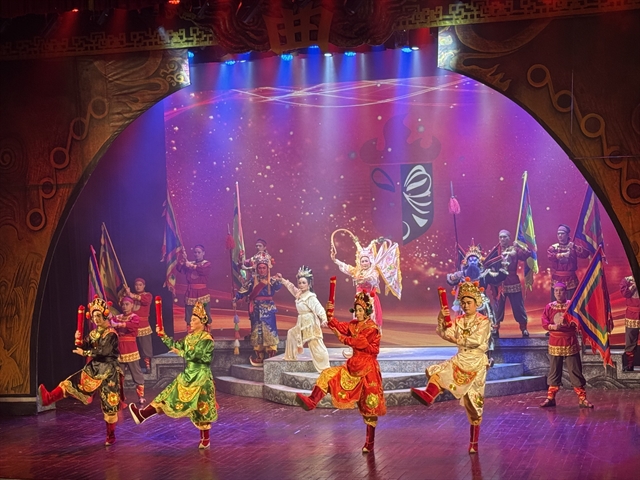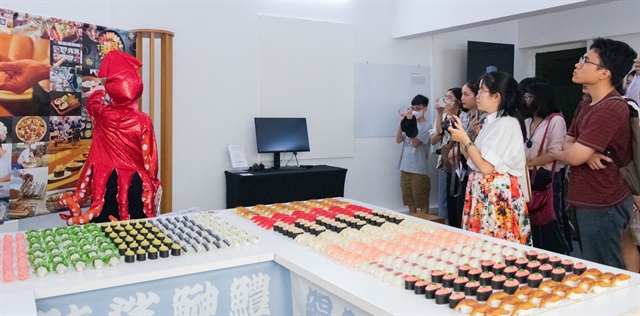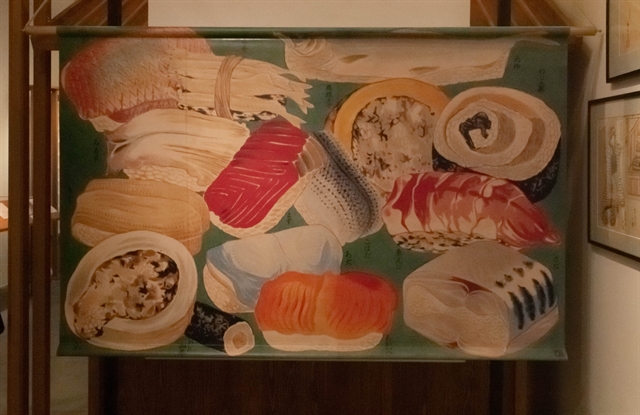 Life & Style
Life & Style


|
| Visitors listen to a Japan Foundation staff introducing the exhibition. Photos courtesy of Japan Foundation |
HÀ NỘI An exhibition at the Japan Foundation Centre for Cultural Exchange offers a chance for local young people to get to know Japanese cuisine.
I Love Sushi exhibition aims to provide an in-depth visual guide to the appeal of sushi. It includes the chance to learn about how Japan took in sushi in its original form and how it modified sushi to suit the natural environment, culture and lifestyles of individual areas.
The exhibition also introduces today’s vibrant sushi culture, and it encourages people to think about the potential of sushi as a food for the future in the light of contemporary food issues.
"Our exhibition this time is part of culture and art exchange activities between Việt Nam and Japan," said Osuka Shoya, head of culture section at the foundation. "We want to introduce sushi because it is typical of Japanese culture with an approach from history.
"There are a lot of sushi models at the exhibition. After Hà Nội exhibition, we will cooperate with Bắc Giang Museum to organise a sushi exhibition at Bắc Giang Museum."
People who know little about sushi will greatly enjoy the exhibition and keen fans of sushi will find it fascinating. The exhibition includes a simulation of a visit to a sushi shop in Edo era in Japan.
In 2013, UNESCO inscribed washoku - Japanese cuisine on its Intangible Cultural Heritage list, and sushi is the archetypal example.
Sushi is a refined and healthy food that looks good and tastes good, and it has already become a familiar item on menus worldwide. From its roots in Southeast Asia or Southern China, sushi reached Japan over a thousand years ago.
Since then, sushi has radically changed, taking advantage of the abundance of natural resources found in and around the islands of Japan, of the application of knowledge and ideas to sushi, and of the never-ending Japanese drive to try good-tasting foods.

|
| Ukiyo-e artwork depicting sushi in the Edo era, displayed at the exhibition I Love Sushi. |
The type of sushi that first comes to mind for most people today is nigiri-zushi, which emerged about two hundred years ago in Edo, the city that now known as Tokyo.
Sushi has now spread outside Japan’s borders and is enjoyed around the world. But although it has become a familiar food, many people have discovered only a few of its attractions.
There is an extremely impressive sushi installation mainly focusing on the dish nigiri-zushi combining 30 pieces of each type of 31 different types of sushi creating a total of 930 pieces of colourful sushi.
Nigiri-zushi, is a type of sushi consisting of an oblong ball of sushi rice typically topped with a little wasabi and a slice of raw fish. The pieces are displayed closely together in a variety of colours creating a nice picture that stands out even among the bright colours of other types of washoku - Japanese cuisine.
Each type of sushi is simple but when it is arranged on a tray to create harmony, demonstrating the ingenuity and sophistication of Japanese chefs.
High technology allows the exhibition visitors to take an online tour of a sushi shop in Japan. The video was shot in collaboration with Kizushi - a long-standing sushi shop that continues the Yohei Sushi tradition in the Ningyo-cho area of Tokyo.
Visitors can watch a Japanese chef skilfully handling sushi ingredients, having been taught age-old techniques through the practice of serving nigiri-zushi during the Edo period.
"It is the first time I've gone to an exhibition of sushi," said Nguyễn Thu Trang, an exhibition visitor. "The exhibition space impresses me and there are many fancy and attractive sushi models."
"I enjoy the experience of the online tour of a sushi restaurant in Japan. I feel like I'm enjoying sushi at a real restaurant. Through the exhibition, I understand a lot about the original and history of sushi and have better understand Japanese culture."
Throughout the exhibition period, side events related to the theme of sushi will also be organised. A talk show on Japanese Sushi - History and Change will be conducted by Professor Hibino Terutoshi on April 21. Terutoshi is an authority on local sushi traditions. He is honourable director of Sushi Shimizu Museum in Shizuoka Prefecture.
Sushi is not just a typical dish of Japanese culture, behind it are very profound historical and cultural contexts of Japan, according to Yonemori Shinsuke, second culture and press secretary at the Japanese embassy.
"I hope that through this exhibition, all of you will have a deeper understanding of Japanese history and culture," Shinsuke said at the exhibition opening ceremony. "We want Vietnamese to get to know more about sushi, its history and development."
The exhibition runs until May 5 at 27 Quang Trung Street. Apart from the main venue, a compact version of the exhibition is held at Aeon Mall Long Biên, 27 Cổ Linh, Long Bien District, where people can also enjoy the real sushi at their food court. VNS




